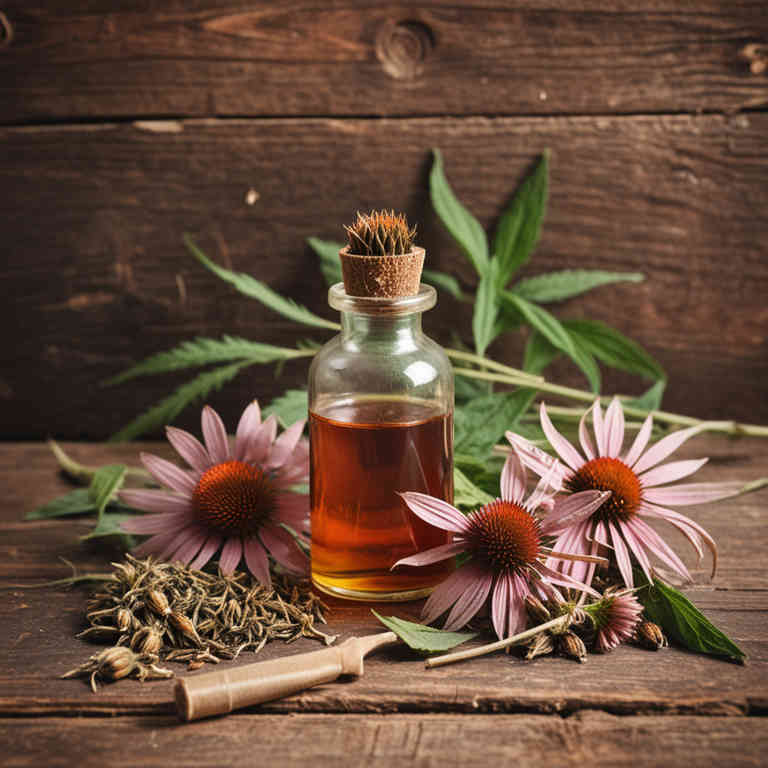Echinacea angustifolia tincture for medicinal use

Echinacea angustifolia tincture is a concentrated herbal preparation made by soaking the dried roots of the Echinacea angustifolia plant in alcohol.
This tincture is commonly used in herbalism to support the immune system and is often taken during cold or flu season. It is believed to have antimicrobial and anti-inflammatory properties that may help reduce the severity and duration of infections. The preparation is typically taken in small doses, either directly or diluted in water.
It is widely used as a natural remedy for respiratory and immune-related conditions.
Uses
Echinacea angustifolia tincture has been used to support immune function and treat infections for centuries, particularly among Native American tribes who traditionally used the plant to treat wounds, sore throats, and respiratory ailments.
Historically, it was valued for its purported ability to boost the body's defenses against colds and flu, and its use was passed down through generations. In modern times, the tincture is widely used as a complementary therapy to reduce the duration and severity of colds and upper respiratory tract infections. It is also sometimes employed for its anti-inflammatory and antimicrobial properties.
Despite its popularity, scientific research on its efficacy remains inconclusive, and it is often used alongside conventional medical treatments.
Benefits
Echinacea angustifolia tincture has health benefits such as boosting the immune system, reducing the duration and severity of colds and upper respiratory infections, and exhibiting anti-inflammatory and antioxidant properties.
It is commonly used to support the body's natural defenses against viral and bacterial infections. The tincture contains compounds like alkamides, caffeic acid derivatives, and polysaccharides, which contribute to its immune-enhancing effects. It may also help alleviate symptoms of allergies and skin conditions due to its anti-inflammatory action.
However, it is important to consult a healthcare professional before use, especially for individuals with autoimmune disorders or those taking other medications.
Constituents
Echinacea angustifolia tincture active constituents include alkamides, caffeic acid derivatives, polysaccharides, and flavonoids.
These compounds are believed to contribute to the plant's immunostimulant properties. Alkamides are thought to interact with the immune system to enhance its response. Caffeic acid derivatives may have anti-inflammatory and antioxidant effects.
Polysaccharides are known to support immune function by promoting the activity of white blood cells.
Preparation
To make Echinacea angustifolia tincture, first gather fresh or dried Echinacea angustifolia plant material, such as leaves, flowers, and roots.
Next, place the plant material in a clean glass jar and cover it completely with high-proof alcohol, such as vodka or grain alcohol. Let the mixture sit in a dark place for 4 to 6 weeks, shaking the jar occasionally to ensure even extraction. After the steeping period, strain the liquid through a fine mesh or cheesecloth to remove the plant matter.
Finally, store the tincture in a dark, cool place in a sealed glass bottle, and use it as needed for its purported immune-supporting properties.
Side Effects
Echinacea angustifolia tincture may lead to mild side effects such as gastrointestinal discomfort, including nausea, vomiting, or diarrhea.
Some individuals may experience allergic reactions, particularly those with a history of allergies to plants in the daisy family. It can also cause skin irritation if applied topically, and in rare cases, it may trigger asthma-like symptoms. Long-term use might lead to decreased effectiveness of the immune-boosting properties.
As with any herbal supplement, it is important to consult a healthcare provider before use, especially for people with existing medical conditions or those taking other medications.